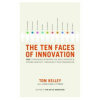|
|
|
|
| |
With many factors which
produce immense impact on rapid evolution of all aspects
of business and technology, such as emergence of new
digital products, disruptive innovations, shortening of
product lifecycles, "flattening" of the world by
removing barriers to the spread of information and
open communication, innovation becomes not only important but
crucial for success. Last year BusinessWeek called our
times "innovation economy": "From
energy to biotech, we may be on the cusp of a new age of
innovation".
It becomes clear that modern innovation is not a single
event but a continuous non-stop activity. It also
becomes clear that creativity and invention are needed
along the entire process of creating and bringing new
products to market. Innovation is not limited to
producing great technological ideas, it is needed for
successful invention of new business models, processes
and services as well as for removing obstacles,
conflicts and bottlenecks, and finding new innovative
ways to increase business performance.
Innovation becomes more than technology, research,
technique or a method; it becomes a culture. Many
organizations simply do not have it yet. While TRIZ
and Systematic Innovation can greatly support creative
parts of a process
of innovation, in order to create and sustain a
long-term innovative organization we also need other
ingredients: innovative and creative people, knowledge,
everyday learning, collaboration and open communication. This is why in this issue we provide you
with information not just limited to TRIZ but to other
aspects of innovation as well.
Successful innovations,
Valeri Souchkov
|
 ANNOUNCEMENT:
NEAREST EVENTS
ANNOUNCEMENT:
NEAREST EVENTS |
|
June 14, 2006 |
One-day
training in Systematic Business Innovation and
Problem Solving
Utrecht, The Netherlands
Hands-on training course for those who wish to learn how to
solve problems related to business and management and
generate new solution strategies by combining systematic
methods and creativity.
More details |
August 31 -
September 2, 2006:
|
2nd TRIZ Symposium in
Japan
Based on the success of the first event, the second TRIZ
symposium in Japan which will be conducted this year invites
broader international audience.
More details |
October 9-11, 2006:
|
ETRIA Conference TRIZ
Future 2006
Next global conference by the European TRIZ Association is
announced to be held in Kortrijk, Belgium,
October 9-11, 2006.
More details |
|
|
 REPORTS
REPORTS |
Another TRIZ Day in the Netherlands took place on April
12, 2006.
Click to see the report
|
 NEW BOOKS
NEW BOOKS |
 |
Thoughtivity for kids
By Tatiana Sidorchuk, Nikolai Khomenko
A comprehensive guide for using TRIZ and other
innovation methods to develop creativity, imagination,
goal-oriented problem-solving skills, and speech
development in children ages 3 through 8.
"From time
to time people ask about teaching TRIZ to kids.
Here you can find a book about this subject. It is a
result of more then 15 years of research and practical
tests within Former USSR. More than 300 teachers were involved to
the testing process. At least 10.000 preschool teachers
were taught during these years by the author and her
followers. Tatiana Sidorchuk - author of the book was
involved this year as a keynote speaker to TRIZCON 2006
in Milwaukee". (Synopsis by Nikolai Khomenko).
|
 |
The Ten Faces of Innovation :
IDEO's Strategies for Defeating the Devil's Advocate and
Driving Creativity Throughout Your Organization
by Thomas Kelley, Jonathan Littman
"Outlining ten major
roles often played on successful and innovative teams,
this book catalogs personas used at IDEO to create new
products and services. The book is easy to read and
contains powerful, persuasive arguments about some of
the activites teams need to participate in to unblock
the rut they're in or to combat negative environments.
I'd recommend this as a light-hearted read for people
who see themselves as an energetic personality and are
interested in coming in to work on a Monday and giving
their team a kick-start" (from Amazon user reviews).
|
 ON THE WEB: INNOVATION,
TRIZ, CREATIVITY
ON THE WEB: INNOVATION,
TRIZ, CREATIVITY |
As usual, we continue
to update you with a selection of recommended recent
papers and other web resources in the areas of TRIZ,
Creativity, and Innovation.
|
-
Do you have problems?
By: Howard Smith and Mark Burnett
A very good introductory overview of using TRIZ for
business process improvement.
-
The Art of Innovation
One-hour streaming online video and PDF presentation
of Guy Kawasaki, presented on January 24th, 2006 at
the Tech Coast Angels “Fast Pitch Competition” at
UCLA, and author of eight books including Rules
for Revolutionaries, How to Drive Your
Competition Crazy, Selling the Dream, and
The Macintosh Way. His talk is about "the art
of start": what to do and what not to do to
successfully start innovative businesses and
introduce innovations. Interesting, that some key
ideas of Kawasaki completely coincide with TRIZ
ideas: such as "jump to the next curve or create new
curve", "increase not by 10 per cent but 10 times",
and so on. Very useful and entertaining.
-
Top-down Innovation
An article from Optimize magazine: "CEOs
say they want to lead the innovation charge, but
they can't go it alone. Collaboration and help from
IT are critical to putting intentions into action."
-
3M's Seven Pillars of
Innovation
By Michael Arndt
It may be 104 years old, but the company churns out
cutting-edge products like a brash new startup. Here
are the secrets of its success.
-
Top Ten Myths about Business
Innovation
By Geoffrey Moore.
"If you are worrying about innovation, take
heart. Only successful companies do. By contrast,
unsuccessful companies either aren’t around to do
any worrying or have more pressing concerns, like
meeting payroll or paying their bills."
-
Innovation, the Google way
by Garett Rogers
"With each product or service they launch, it
becomes more difficult to imagine a world without
them. One of my readers asks: What can other
businesses (of any size) learn from what Google has
done to achieve this level of success?"
-
A missing link in Innovation
by Mike Klein
Whar are the missing links between innovation vs.
invention?
According to Peter Denning, Director of
the Cebrowski Institute for information innovation
and superiority at the Naval Postgraduate School in
Monterey, California, it is the individual's skill
at innovating. He has identified a seven-part
framework called the "Personal Foundational
Practices," which can be taught to individuals and
endorsed by organizations wishing to stimulate a
culture of innovation.
-
Nuggets from IBM Business
Leadership Forum in Rome
A summary on insights reported by IBM about modern
innovation
-
BMW Innovation Day 2006
A good summary of the Innovation Day 2006,
where BMW presented the latest developments in
drivetrain technology, energy management, and
materials technology which help to "convincingly
fulfill current and future-oriented customer wishes
for even more efficient energy concepts and to
master the challenges of tomorrow". One of the TRIZ
trends of system evolution is the trend of
increasing the degree of system dynamics, and it is
not surprising that under the term
“EfficientDynamics” BMW sums up all development
activities serving to achieve this supreme standard.
-
The World's Most Innovative
Companies
Their creativity goes beyond products to rewiring
themselves. BusinessWeek and the Boston Consulting
Group rank the best.
-
From Edison's Desk is the blog
of GE Global Research
GE Global Research offers a unique forum for
technology enthusiasts around the globe to discuss
the future of technology with top researchers from
one of the world's largest and most diverse
industrial research labs.
-
Innovation Leaders
Innovaro conducts an annual assessment of the
innovation performance of 1000 companies across 20
key sectors. This is based on detailed research into
8 key areas that is summarized in an innovation
scorecard. Based on extensive analysis of the
performance, Innovation Leaders profiles the
organizations that are making the most impact today.
-
Creativity in reverse: a new
way to use TRIZ
By Jack Hipple
"Sometimes, though, the problem is not one of
trying to improve something, but to find the cause
of a failure in a system, product, or organization.
Something has gone wrong, maybe on a once in a while
basis, and we can’t figure out why. We develop
hypothesis derived from checklists we had previously
developed, or from conventional brainstorming
ideation techniques. But we don’t always get to the
root cause and have to deal with the problem again
at a future date".
-
Applying TRIZ in Process
Improvement
by Haiyan Ru and Haibo Ru
Two authors from China present a case study of
applying TRIZ to improve the effectiveness of
internal training process.
|
 STORIES:
TRIZ OR NOT... AGAIN, USE RESOURCES
STORIES:
TRIZ OR NOT... AGAIN, USE RESOURCES |
This time we again talk about using resources to
innovate. Resource-based thinking is extremely powerful
instrument to create new ideas and solve existing
problems. The term "resource" has many different
meanings, but in general, resource is something that is
readily available (or easily obtainable) and might
provide us with the needed function or value within
different contexts to reach the desired purpose.
In xTRIZ, we define the following categories of
resources: Space, Time, System (everything that belongs
to a certain system), Supersystem resources (everything
that interacts with a system or can interact),
Functional resources. In turn, system and supersystem
resources include material, energy, human and
information components. We often neglect available
resources whereas they can be excellent sources for
creating new value, solving existing problems,
delivering required functions and resolving
contradictions. Many new ideas can arise on the basis of
using available energy sources which we usually ignore,
or already existing components in a system; or simply by
combining existing components to obtain new functions
thus saving space, time, material and energy. Often
there is no need to create a new system or subsystem to
deliver a new function: it is enough to use what is
already available as a whole or as a part.
When we use TRIZ to solve a specific problem we always
first look at the already existing internal resources
and very often they help to find a needed solution.
A good introductory overview with examples explaining
the concept of using resources in technology is
available at
http://www.ideationtriz.com/TRIZ_tutorial_4.htm
(By Ideation International, Inc).
Among some other recent examples (again, note that they
were not necessarily obtained with TRIZ, but illustrate
the concept):
|
 |
Sony
Skype Phone: no need for a separate device
Sony announced the launch of the MouseTalk (trying to find
an English link), a new VAIO PC peripheral that acts as both
an optical mouse and an Internet phone. The clamshell mouse,
which will be Skype certified, flips open to become an
Internet phone to make and receive calls around the world
through Skype. (the website is in Japanese but pictures are
self-explaining).
http://www.ecat.sony.co.jp/vaio/acc/acc.cfm?PD=23389
|
 |
Curtains that Brighten Your Living Room
A group of scientists at GE Global Research, together with
many researchers around the world, have been working around
the clock to make such curtain-like lighting applications
possible. Accordingly they have also been changing the
"common-sense" about lighting devices. No more light bulbs,
no more light tubes. In their vision, the future lighting
device could be made into different forms with features such
as thin (no thicker than a credit card), flexible and rugged
(curtains, wallpapers, you name it!), and many more. The
device under development is based on an emerging technology
called organic light-emitting devices (OLED). In its
simplest picture, an OLED consists of a layer of organic
plastic-like material sandwiched between two electrodes. The
device emits light upon application of a battery-type
voltage.
http://www.grcblog.com/fullview.php?blog_id=41
|
 |
Skype
is there, let's use it for mobile calls
Company SoonR just announced Soonr Talk, which will allow
Skype calls to be made from a standard cell phone. It will
work through SoonR’s basic product - access Skype on your
home PC through your browser and initiate a call with a
contact or contacts.
http://www.soonr.com/web/front/home.jsp
|
 |
So
many free resources around - why not to use them?
Ambient Micro´s Multi-Source Ambient Power Supply module
combines the output of solar, vibration, temperature
gradient, and RF Magnetic ambient energy technology to
continuously recharge an on-board battery or micro-battery.
http://ambient-micro.com/
|
 |
Using
temperature difference to generate energy
Thermo Life® is a micro-technology device which provides
viable energy source for low-powered devices such as micro
sensor systems, ZigBee chipsets, wearable electronics,
implantable medical devices, active RFID tags and numerous
other applications. Wherever a temperature difference exists
in any environment, the autonomous device, Thermo Life®, is
capable of producing an output power. Even small temperature
differences of less than 5 Kelvin can provide a source of
thermal energy. Thermo Life® converts heat energy to
electrical energy through its thermopile couples using the
thermopile principle (Seebeck effect).
http://www.poweredbythermolife.com/thermolife.htm
|
 |
Pak-lite:
a flashlight without the body.
When we think about flashlight, we imagine a body for the
battery, lamp, protective glass. In this product, the
battery is a body. Just place a cup with two LEDs on the 9v
standard battery and the flashlight is ready.
http://www.9voltlight.com/inc/sdetail/61
|
|
|
|
 |
Wiki:
a resource for using resources
While Wiki was originally invented as a platform for
Wikipedia, today Wiki becomes online collaboration tool
which is used for different purposes. Explore several online
videos about how Wiki can be used to enable collaboration
and most effectively use human resources
http://news.com.com/1200-2-5741150.html
|
|

|
A
House Powered By Spinach
Seattle architecture/design firm Mithun won first place in
the C2C Home Competition with their design for a house
powered by spinach.
http://www.coolbusinessideas.com/archives/a_house_powered_by_spinach.html |
 TRIZ FOR CREATIVE
PHOTOGRAPHY?
TRIZ FOR CREATIVE
PHOTOGRAPHY? |
This little experiment outside my usual working activities
was very interesting: I was thinking if 40 Altshuller
Principles could be used to produce some unusual ideas for
creative photography. While not being a professional
photographer, it is difficult to judge about quality and
novelty, but I think this can help all of us to make
interesting pictures. So to begin with, I took Inventive
Principle #26: The Use of Copies, which says:
- Instead of an
unavailable, expensive, fragile object, use simpler and
inexpensive copies.
- Replace an object, or
process with optical copies.
- If visible optical
copies are already used, move to infrared or ultraviolet
copies.
So why not to capture copies
of objects (in this case, shadows) instead of the objects? This is the result (click
to enlarge):
|
|


It is interesting that
almost every inventive principle can help with generating
interesting ideas. In addition, combinations of different
principles can propose even much more space for creativity.
|
© 2006, ICG T&C
Disclaimer: ICG Training & Consulting may not be responsible
for the contents of the web links apart from those linked
directly to ICG
T&C' web site.
|
|

